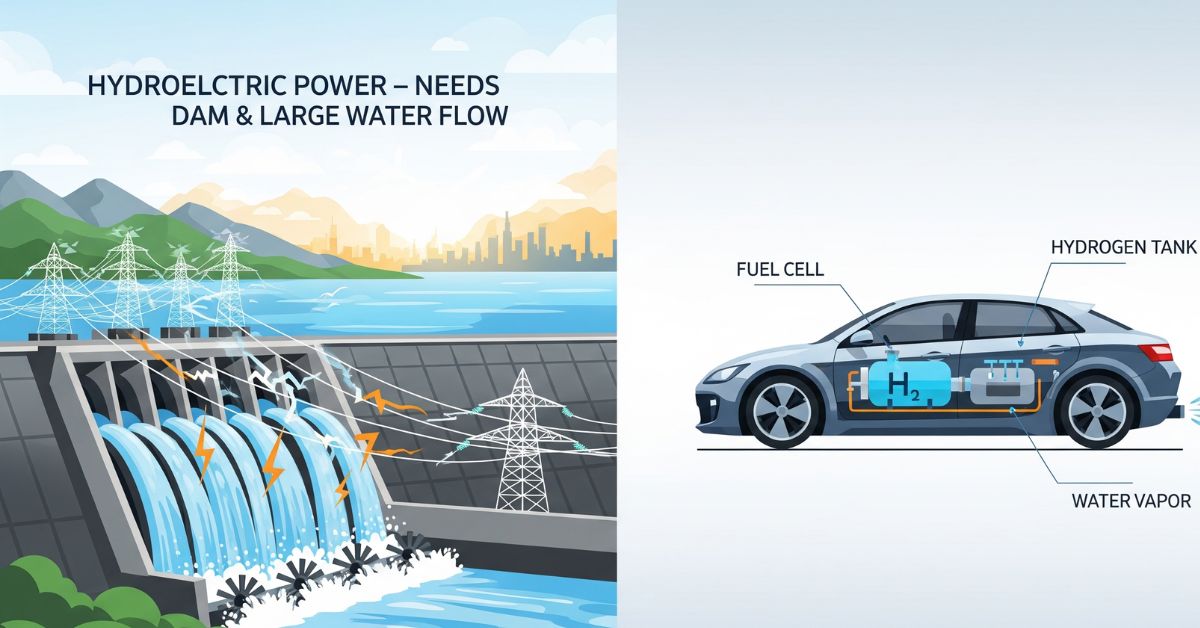The simple answer to why are there not a lot of hydroelectric cars is that the idea itself is based on a misunderstanding of how physics and energy transfer work. A car cannot run directly on the power of water in the same way a hydroelectric dam does, because the process requires conditions that simply can’t be replicated in a moving vehicle.
Hydroelectric power needs a huge volume of water and a significant drop in height to create enough force to generate electricity. This requires large infrastructure like dams, reservoirs, and turbines—none of which can be miniaturized to fit inside a passenger car. For a vehicle to work this way, it would have to carry a tiny dam and an enormous amount of water, which is not only impractical but impossible from both a design and engineering perspective.
Hydroelectric Cars vs Hydrogen-Powered Cars
The confusion about hydroelectric cars often comes from mixing them up with hydrogen-powered cars. While both have a connection to water, they work in completely different ways. A hydrogen car, or Fuel Cell Electric Vehicle (FCEV), uses hydrogen as fuel to generate electricity, which then powers the motor. The only emission from this process is water vapor.

The hydrogen used in these cars is often made through electrolysis, where electricity is used to split water into hydrogen and oxygen. This is an important difference—the car isn’t running on water, it’s running on hydrogen. While the electricity for electrolysis could come from a hydroelectric dam, the car itself is not “hydroelectric.”
Why Hydrogen Cars Haven’t Become Mainstream

One big reason hydrogen cars haven’t taken over the market is the lack of infrastructure. Unlike battery electric vehicles (BEVs) that can be charged at home or at an increasing number of public chargers, hydrogen fuel cell cars need special refueling stations. These stations are costly to build and maintain, so there aren’t many available. This creates a “chicken-and-egg” problem—automakers don’t want to produce large numbers of hydrogen cars without enough stations, and companies don’t want to build stations without enough hydrogen cars on the road.
The Environmental and Efficiency Challenges of Hydrogen

Producing hydrogen isn’t always environmentally friendly. While it can be made through electrolysis using renewable energy like hydroelectric power, most hydrogen today comes from natural gas through a process called steam-methane reforming, which releases carbon emissions. This reduces the environmental benefits of having a zero-emission vehicle. Another big challenge is efficiency—when electricity is used to make hydrogen, then it’s compressed, transported, and converted back into electricity in a fuel cell to power a car, a lot of energy is lost at each step. In comparison, charging a battery electric car directly from the power grid is a much more efficient way to use energy.
The Safety and Storage Challenges of Hydrogen

Storing and handling hydrogen comes with its own set of challenges. It’s a highly flammable gas that must be kept under very high pressure in specially designed, crash-tested tanks. While these tanks are made to be extremely safe, many people still see hydrogen as risky—partly because of historical events like the Hindenburg disaster. Even when compressed, hydrogen has a low energy density, meaning you need a large, heavy tank to store enough fuel for a decent driving range. This can affect both the design and performance of a car.
Why Hydroelectric Cars Don’t Exist – and the Reality of Hydrogen Cars

In short, “hydroelectric cars” don’t exist because the idea is scientifically impossible on a practical scale. The way hydroelectric power works simply can’t be applied to a personal vehicle. Most people who use the term actually mean “hydrogen cars,” which are a real technology but come with their own set of challenges.
Hydrogen cars face big hurdles, including a lack of refueling stations, the energy losses in producing hydrogen, and the high costs of both the vehicles and the fuel. These challenges have allowed battery electric vehicles to become the main choice for sustainable transport. While hydrogen may still find a place in heavy-duty industries like trucks or buses, for everyday drivers, battery electric cars remain the more convenient and efficient option for the future.

